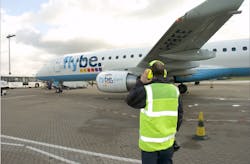Ground service providers have many time-sensitive tasks to perform while carrying out a safe aircraft turnaround. Any added efficiency makes a ground handler’s job smoother, particularly when preparing for and executing a push back.
Replacing a corded headset with a wireless version, for example, allows ramp agents greater range on the ramp and reduces potential hazards on the ground, according to Steve Brown, vice president at SRS Tactical.
The 121-Ground Crew Bluetooth Wireless Ground Mechanic Headset and dongle allow instant wireless communication between personnel on the ground and the flight deck.
The headset, which is manufactured by A-Kabel in Norway, has been offered by SRS Tactical as the 121-Ground Crew model for approximately 10 years.
“Once the Bluetooth headset and dongle have been paired, the user simply turns the units on and they automatically connect to each other,” Brown says, adding that pairing the two components takes a matter of seconds.
Utilizing Class 1 Bluetooth technology, the dongle’s range provides a ground service provider with clear communication within a 50-meter radius.
“The other option is a wired option,” Brown says, adding a 25-foot curly cord connects the flight deck to the pushback tug. “This has its limitations, together with service issues, with constant strain on connectors, cables being run over or cut, tripping hazards. Dangling cables often have worn down connectors that need replacing.”
The device uses a Bluetooth piconet, which ensures that the headset and dongle cannot cross-talk with other units accidentally.
“We do a version that will connect to another headset to provide full duplex communication via Bluetooth between headsets,” Brown explains.
Without cords present, there is less equipment to carry in each tug.
“The operator has more freedom to move and less risk of tripping over cables, leading to possible accidents,” Brown says.
The Bluetooth adaptor's dongle interfaces with aircraft via a simple connection into the external ICS via 1/4-inch stereo connector. If the aircraft has a dual plug connection, SRS Tactical offers an adaptor for 1/4-inch female to dual 1/4-inch connectors.
As an added safety measure, the dongle can be connected to the nose wheel safety pin to ensure removal before take-off.
The 121-Ground Crew headset and Bluetooth adaptor each operate on two AA rechargeable batteries. The equipment’s intelligent charger can detect if normal alkaline batteries are inserted, which prevents them from being charged accidentally.
There is no need for the headset and dongle to be re-paired between battery changes or when turning on/off. What’s more, both the dongle and headset units can also be charged via an external socket.
The reliable equipment has undergone firmware updates since it was originally launched.
The hi-visibility fluorescent green and yellow color options and added hearing protection - including a noise reduction rating (NRR) of 21 decibels - provide ground service personnel additional safety benefits.
Brown adds that customer feedback has been favorable, specifically in regard to the clarity of communication and the simplistic set-up and use. One example of its user-friendly function is a flashing LED that indicates the headset and dongle are in operation.
Additional features include an on/off volume control positioned on the ear shell for ease of use and high attenuation ear cups for enhanced hearing protection.
The headset’s quick-positioning, noise-canceling microphone filters out background noise to aide clear speech transmission. And the headset includes a removable high-visibility headband cover.
To keep the 121-Ground Crew headset in good working condition, Brown advises users to replace hygiene kits regularly and to allow the equipment to dry out if it becomes saturated. He adds that long-term cost savings can be achieved due to reduced repair costs. For example, all of the 121-Ground Crew headset’s metal parts are made of stainless steel for increased durability.






